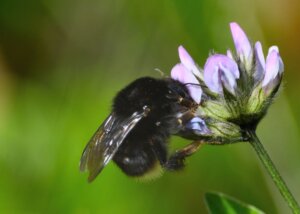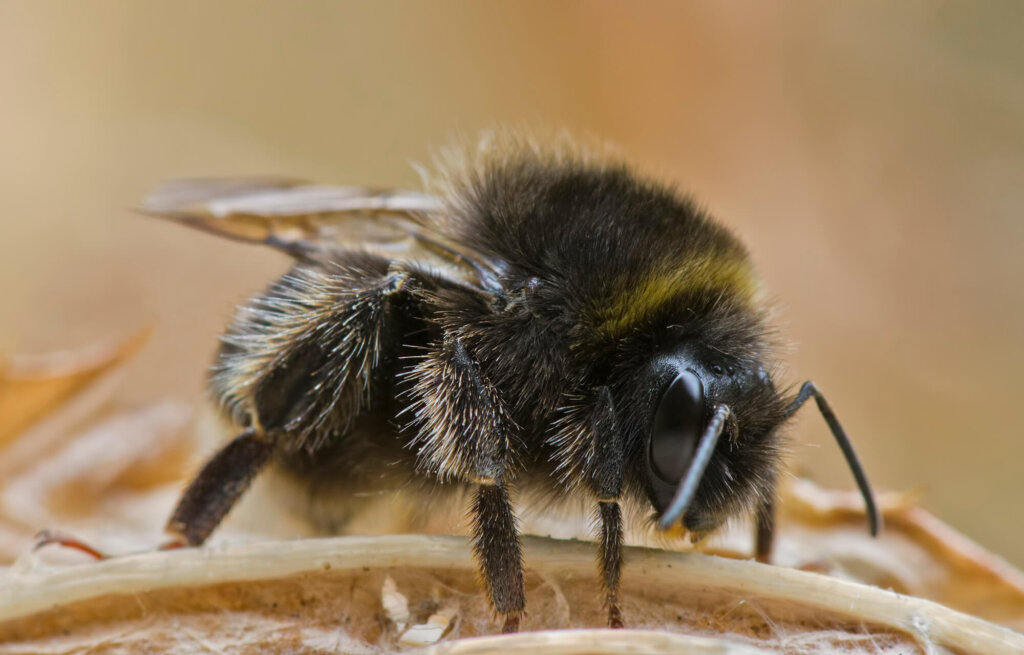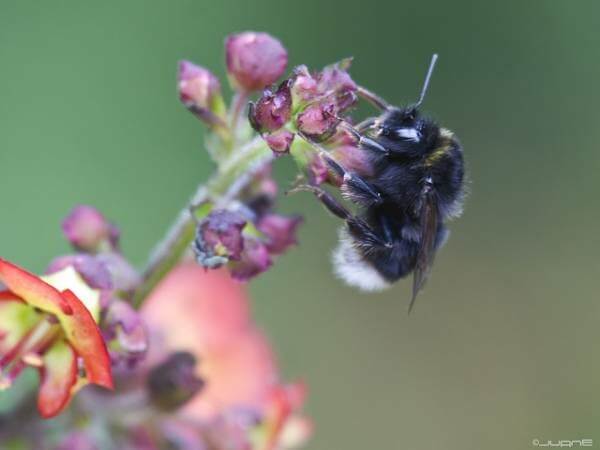Did You Know the Canary Islands Have Their Own Bumblebee?


Written and verified by the biologist Georgelin Espinoza Medina
The Canary Islands is a Spanish archipelago with a total area of 7447 square kilometers, formed by 7 major islands and several islets. It has a great diversity of animals – more than 17,000 terrestrial species, and around 7,760 marine species. It also has many autochthonous beings – species that only inhabit this area. And, curiously, the Canary Islands have their own bumblebee! Find out all about it here!
This insect is called the Canary Island bumblebee and scientifically Bombus terrestris canariensis, making it a subspecies of the common bumblebee. However, some experts consider it a separate species. If you’re intrigued by it already, then we invite you to read all about it and get to know this particular specimen, without the need to travel to the archipelago.
Where does the Canary Islands bumblebee live?

Although we’ve already mentioned that it’s an endemic species of this archipelago, it’s interesting to note that you can’t find it just anywhere on the islands. It is, however, found on almost all the major islands (El Hierro, La Palma, La Gomera, Tenerife, and Gran Canaria), although it isn’t on Lanzarote. In Fuerteventura, it has been artificially introduced for the pollination of some crops, such as tomatoes.
Characteristics of the endemic Canary Islands bumblebee
The bumblebee belongs to the group of arthropods. Specifically, in the order Hymenoptera order, and the Apidae family, along with regular bees. They have a robust, wide and hairy body, as they’re covered by long, compact bristles.
They are black, but are easily distinguished by a white stripe at the end of the abdomen. In addition, males have yellow to reddish hairs on the second segment of the dorsum.
The whitish stripe on the abdomen allows it to be commonly called the white-tailed bumblebee.
Canary bumblebees are social insects, as are other types of Hymenoptera. There are members with different functions within the colony. In particular, we have the queens that are in charge of laying the eggs, the workers that maintain and feed the young, and the males or drones that are useful for reproduction.
The castes have different sizes, the queens are the largest, measuring between 20 and 23 millimeters in length (nearly an inch), followed by the males who are around to 17 millimeters (two-thirds of an inch). Finally, the smallest are the workers, from 14 to 16.
It’s also necessary to know that males or drones don’t have a stinger.
Feeding
This animal feeds on nectar and pollen, which is why it’s of great importance as a pollinator of various types of flowering plants. It’s a generalist, which means that it has no preference for any particular species.
Life cycle
Bumblebees have an ephemeral life, since they have an annual cycle. This begins with the copulation of young queens and males after they become adults. During autumn, the queens disperse and consume food in appropriate quantities, because they’re preparing to hibernate in a quiet and dry place. It’s the only caste that can carry out this process.
After the dormancy period, when soil temperatures increase due to the arrival of spring, the queens come out and prepare for egg development. They also look for a suitable site on the ground to build their hive and lay their eggs.
From the first eggs, workers emerge and are fed and cared for by the queen. When they become adults, they take over the maintenance tasks of the colony, so that the queen can dedicate herself to the laying tasks.
In the final stage of the life of the hive, other queens and the males of the colony emerge. These are the product of unfertilized eggs, unlike the females.
The queen dies at the end of the summer. The young and males reproduce when they become adults. In this way, the cycle begins again and the queen prepares for hibernation.
Natural enemies
Like all other animals, bumblebees have natural enemies. These can be of different types. Among them are spiders, beetles, mosquitoes, fungi and others. One parasite that has been studied is the Parasitellus fucorum mite which uses the queen as a means of transport. In an investigation carried out in Tenerife, 15 queens out of 173 collected (8.7 %) were found to have these mites on their bodies.
Importance of the Canary Island bumblebee

These insects are listed in the Canary Islands Catalog of Protected Species, not because they are endangered, but because they’re considered a species of interest for ecosystems, all thanks to the vital importance they have as pollinators of the flowering plants on the islands.
Moreover, thanks to this pollinating role, their supporting role in agriculture has also been highlighted, as they create advantages in the yield and quality of different crops, among them tomatoes and other vegetables and fruits.
In short, you now know that the Canary Islands has its own bumblebee, an endemic insect that is very important for the pollination of different types of flowering plants. Besides, it’s a key specimen for the ecosystem, and it isn’t the appearance or size that matters, but how useful they are.
The Canary Islands is a Spanish archipelago with a total area of 7447 square kilometers, formed by 7 major islands and several islets. It has a great diversity of animals – more than 17,000 terrestrial species, and around 7,760 marine species. It also has many autochthonous beings – species that only inhabit this area. And, curiously, the Canary Islands have their own bumblebee! Find out all about it here!
This insect is called the Canary Island bumblebee and scientifically Bombus terrestris canariensis, making it a subspecies of the common bumblebee. However, some experts consider it a separate species. If you’re intrigued by it already, then we invite you to read all about it and get to know this particular specimen, without the need to travel to the archipelago.
Where does the Canary Islands bumblebee live?

Although we’ve already mentioned that it’s an endemic species of this archipelago, it’s interesting to note that you can’t find it just anywhere on the islands. It is, however, found on almost all the major islands (El Hierro, La Palma, La Gomera, Tenerife, and Gran Canaria), although it isn’t on Lanzarote. In Fuerteventura, it has been artificially introduced for the pollination of some crops, such as tomatoes.
Characteristics of the endemic Canary Islands bumblebee
The bumblebee belongs to the group of arthropods. Specifically, in the order Hymenoptera order, and the Apidae family, along with regular bees. They have a robust, wide and hairy body, as they’re covered by long, compact bristles.
They are black, but are easily distinguished by a white stripe at the end of the abdomen. In addition, males have yellow to reddish hairs on the second segment of the dorsum.
The whitish stripe on the abdomen allows it to be commonly called the white-tailed bumblebee.
Canary bumblebees are social insects, as are other types of Hymenoptera. There are members with different functions within the colony. In particular, we have the queens that are in charge of laying the eggs, the workers that maintain and feed the young, and the males or drones that are useful for reproduction.
The castes have different sizes, the queens are the largest, measuring between 20 and 23 millimeters in length (nearly an inch), followed by the males who are around to 17 millimeters (two-thirds of an inch). Finally, the smallest are the workers, from 14 to 16.
It’s also necessary to know that males or drones don’t have a stinger.
Feeding
This animal feeds on nectar and pollen, which is why it’s of great importance as a pollinator of various types of flowering plants. It’s a generalist, which means that it has no preference for any particular species.
Life cycle
Bumblebees have an ephemeral life, since they have an annual cycle. This begins with the copulation of young queens and males after they become adults. During autumn, the queens disperse and consume food in appropriate quantities, because they’re preparing to hibernate in a quiet and dry place. It’s the only caste that can carry out this process.
After the dormancy period, when soil temperatures increase due to the arrival of spring, the queens come out and prepare for egg development. They also look for a suitable site on the ground to build their hive and lay their eggs.
From the first eggs, workers emerge and are fed and cared for by the queen. When they become adults, they take over the maintenance tasks of the colony, so that the queen can dedicate herself to the laying tasks.
In the final stage of the life of the hive, other queens and the males of the colony emerge. These are the product of unfertilized eggs, unlike the females.
The queen dies at the end of the summer. The young and males reproduce when they become adults. In this way, the cycle begins again and the queen prepares for hibernation.
Natural enemies
Like all other animals, bumblebees have natural enemies. These can be of different types. Among them are spiders, beetles, mosquitoes, fungi and others. One parasite that has been studied is the Parasitellus fucorum mite which uses the queen as a means of transport. In an investigation carried out in Tenerife, 15 queens out of 173 collected (8.7 %) were found to have these mites on their bodies.
Importance of the Canary Island bumblebee

These insects are listed in the Canary Islands Catalog of Protected Species, not because they are endangered, but because they’re considered a species of interest for ecosystems, all thanks to the vital importance they have as pollinators of the flowering plants on the islands.
Moreover, thanks to this pollinating role, their supporting role in agriculture has also been highlighted, as they create advantages in the yield and quality of different crops, among them tomatoes and other vegetables and fruits.
In short, you now know that the Canary Islands has its own bumblebee, an endemic insect that is very important for the pollination of different types of flowering plants. Besides, it’s a key specimen for the ecosystem, and it isn’t the appearance or size that matters, but how useful they are.
All cited sources were thoroughly reviewed by our team to ensure their quality, reliability, currency, and validity. The bibliography of this article was considered reliable and of academic or scientific accuracy.
- Gobierno de Canarias. (s.f.). Bombus terrestris canariensis Perez, 1895. Recuperado el 02 de enero de 2023, disponible en: https://www.biodiversidadcanarias.es/biota/especie/A00122
- Hernández, J., Ortiz-Sánchez, F., Montesdeoca, M., & Carnero, A. (2003). Método de cría de Bombus canariensis Pérez, 1895 en condiciones controladas. Phytoma, 154, 42-46.
- Oromí, P., Zurita, N., Morales, E., & López, H. (2015). Diversidad de artrópodos terrestres en las Islas Canarias. Revista IDE@ – SEA, 4, 1–14.
- Ortiz-Sánchez, F., Hernández, J., Montesdeoca, M., & Carnero, A. (2002). Parasitellus fucorum (De Geer, 1778) (Mesostigmata, Parasitidae), ácaro forético asociado al abejorro canario, Bombus canariensis Perez, 1895 (Hymenoptera, Apidae). Vieraea, 30, 161-166.
- Parlamento de Canarias. (2009). Proposición de Ley del catálogo canario de especies protegidas. Boletín oficial del Parlamento de Canarias, 238(2). Recuperado el 02 de enero de 2023, disponible en: https://www.parcan.es/pub/bop/7l/2009/238/bo238.pdf
This text is provided for informational purposes only and does not replace consultation with a professional. If in doubt, consult your specialist.








